Case Study on Acute Illness: Medication and Multidisciplinary Team
VerifiedAdded on 2023/06/07
|7
|1626
|205
AI Summary
This case study describes the medication and multidisciplinary team required for the treatment of acute abdominal pain in lower left quadrant (LLQ) of Bob Jackson. The report suggests NSAIDs for abdominal pain and sulfasalazine for Ulcerative Colitis. The role of a dietician in Bob's acute illness is also highlighted.
Contribute Materials
Your contribution can guide someone’s learning journey. Share your
documents today.
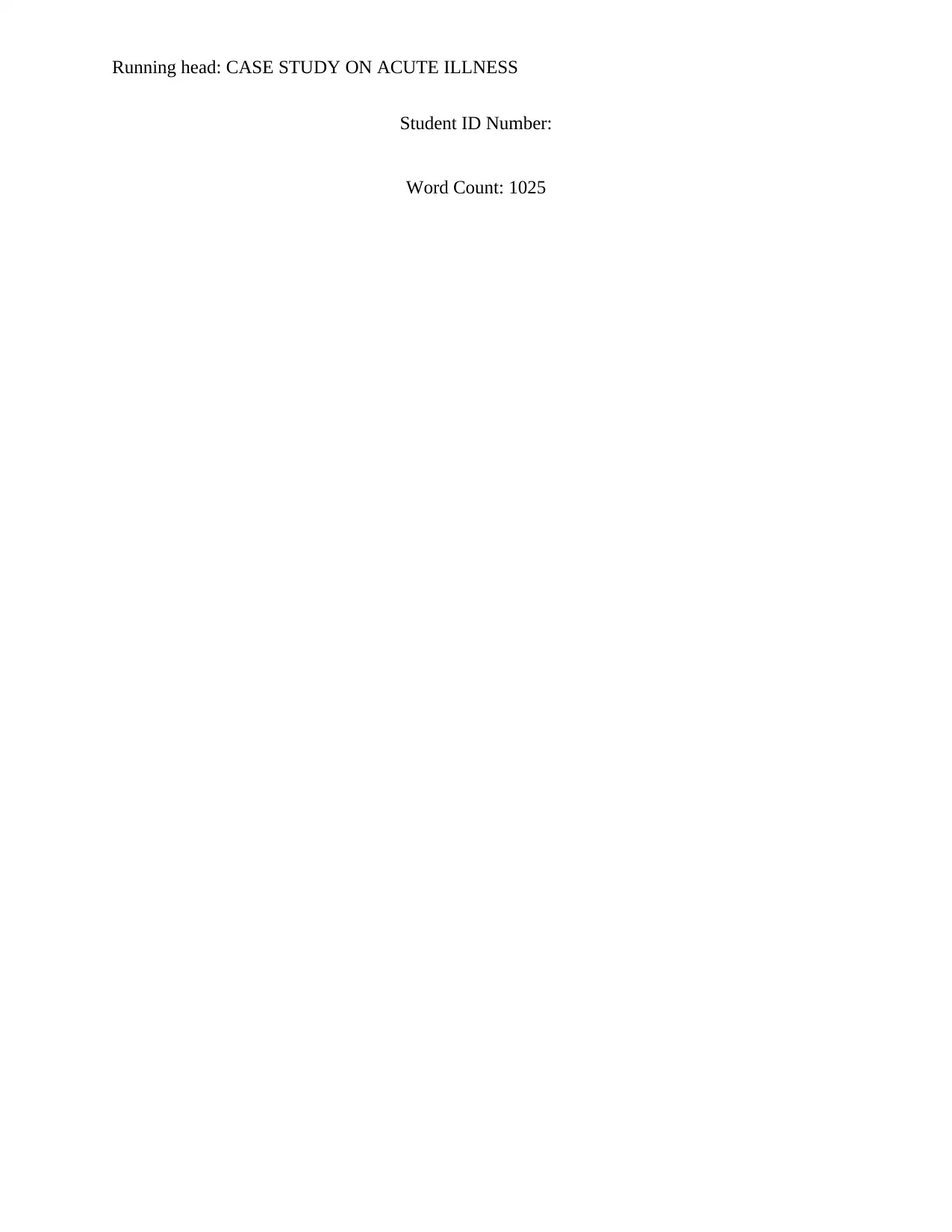
Running head: CASE STUDY ON ACUTE ILLNESS
Student ID Number:
Word Count: 1025
Student ID Number:
Word Count: 1025
Secure Best Marks with AI Grader
Need help grading? Try our AI Grader for instant feedback on your assignments.
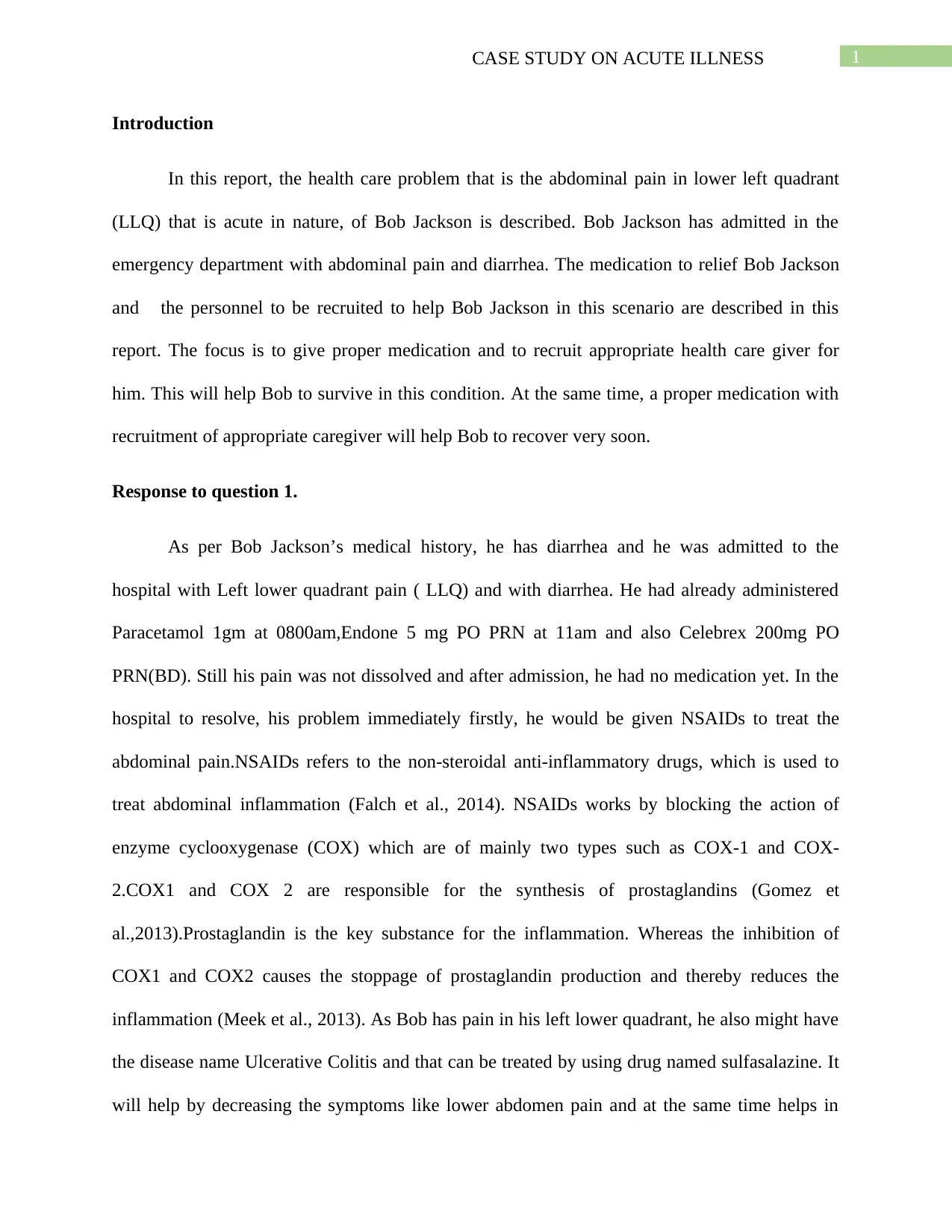
1CASE STUDY ON ACUTE ILLNESS
Introduction
In this report, the health care problem that is the abdominal pain in lower left quadrant
(LLQ) that is acute in nature, of Bob Jackson is described. Bob Jackson has admitted in the
emergency department with abdominal pain and diarrhea. The medication to relief Bob Jackson
and the personnel to be recruited to help Bob Jackson in this scenario are described in this
report. The focus is to give proper medication and to recruit appropriate health care giver for
him. This will help Bob to survive in this condition. At the same time, a proper medication with
recruitment of appropriate caregiver will help Bob to recover very soon.
Response to question 1.
As per Bob Jackson’s medical history, he has diarrhea and he was admitted to the
hospital with Left lower quadrant pain ( LLQ) and with diarrhea. He had already administered
Paracetamol 1gm at 0800am,Endone 5 mg PO PRN at 11am and also Celebrex 200mg PO
PRN(BD). Still his pain was not dissolved and after admission, he had no medication yet. In the
hospital to resolve, his problem immediately firstly, he would be given NSAIDs to treat the
abdominal pain.NSAIDs refers to the non-steroidal anti-inflammatory drugs, which is used to
treat abdominal inflammation (Falch et al., 2014). NSAIDs works by blocking the action of
enzyme cyclooxygenase (COX) which are of mainly two types such as COX-1 and COX-
2.COX1 and COX 2 are responsible for the synthesis of prostaglandins (Gomez et
al.,2013).Prostaglandin is the key substance for the inflammation. Whereas the inhibition of
COX1 and COX2 causes the stoppage of prostaglandin production and thereby reduces the
inflammation (Meek et al., 2013). As Bob has pain in his left lower quadrant, he also might have
the disease name Ulcerative Colitis and that can be treated by using drug named sulfasalazine. It
will help by decreasing the symptoms like lower abdomen pain and at the same time helps in
Introduction
In this report, the health care problem that is the abdominal pain in lower left quadrant
(LLQ) that is acute in nature, of Bob Jackson is described. Bob Jackson has admitted in the
emergency department with abdominal pain and diarrhea. The medication to relief Bob Jackson
and the personnel to be recruited to help Bob Jackson in this scenario are described in this
report. The focus is to give proper medication and to recruit appropriate health care giver for
him. This will help Bob to survive in this condition. At the same time, a proper medication with
recruitment of appropriate caregiver will help Bob to recover very soon.
Response to question 1.
As per Bob Jackson’s medical history, he has diarrhea and he was admitted to the
hospital with Left lower quadrant pain ( LLQ) and with diarrhea. He had already administered
Paracetamol 1gm at 0800am,Endone 5 mg PO PRN at 11am and also Celebrex 200mg PO
PRN(BD). Still his pain was not dissolved and after admission, he had no medication yet. In the
hospital to resolve, his problem immediately firstly, he would be given NSAIDs to treat the
abdominal pain.NSAIDs refers to the non-steroidal anti-inflammatory drugs, which is used to
treat abdominal inflammation (Falch et al., 2014). NSAIDs works by blocking the action of
enzyme cyclooxygenase (COX) which are of mainly two types such as COX-1 and COX-
2.COX1 and COX 2 are responsible for the synthesis of prostaglandins (Gomez et
al.,2013).Prostaglandin is the key substance for the inflammation. Whereas the inhibition of
COX1 and COX2 causes the stoppage of prostaglandin production and thereby reduces the
inflammation (Meek et al., 2013). As Bob has pain in his left lower quadrant, he also might have
the disease name Ulcerative Colitis and that can be treated by using drug named sulfasalazine. It
will help by decreasing the symptoms like lower abdomen pain and at the same time helps in
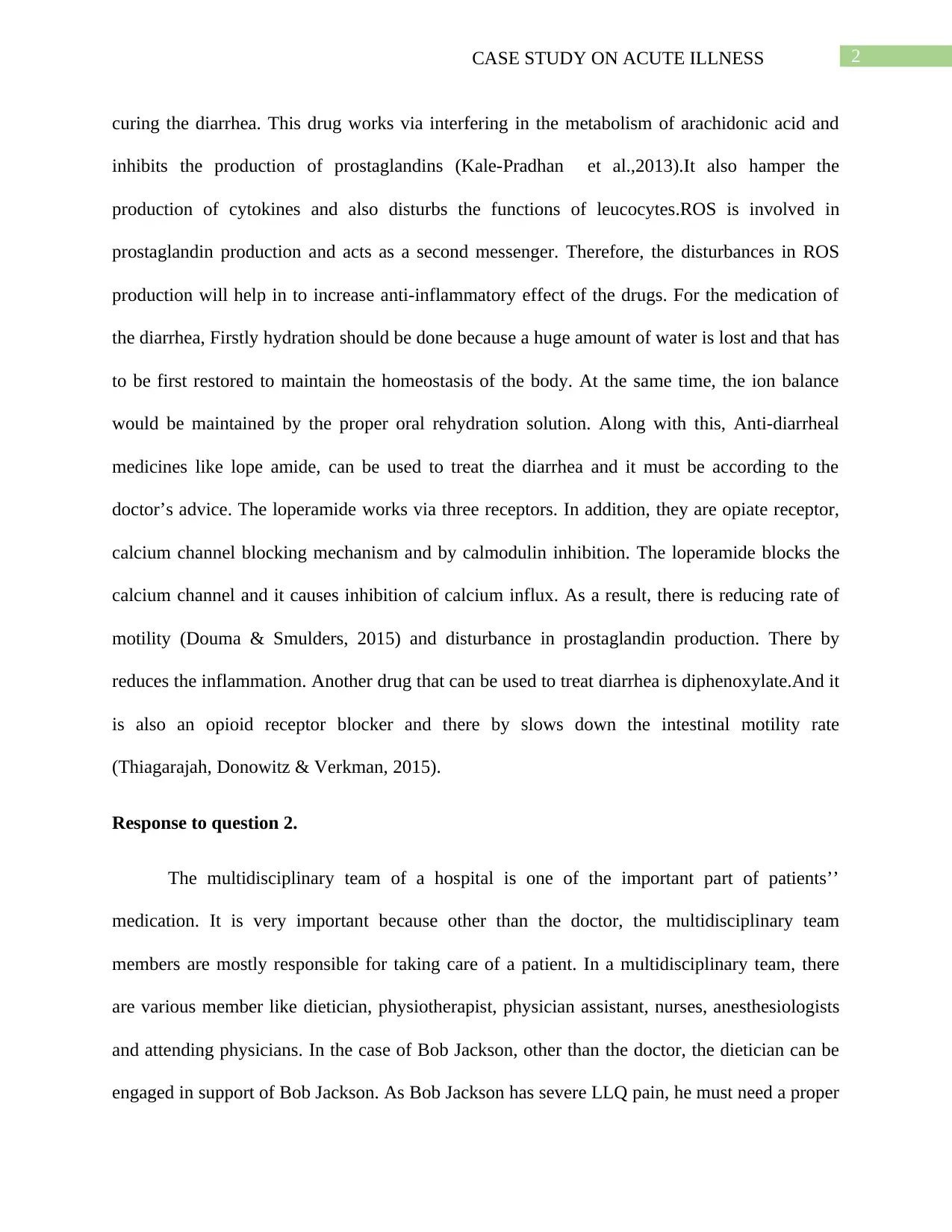
2CASE STUDY ON ACUTE ILLNESS
curing the diarrhea. This drug works via interfering in the metabolism of arachidonic acid and
inhibits the production of prostaglandins (Kale-Pradhan et al.,2013).It also hamper the
production of cytokines and also disturbs the functions of leucocytes.ROS is involved in
prostaglandin production and acts as a second messenger. Therefore, the disturbances in ROS
production will help in to increase anti-inflammatory effect of the drugs. For the medication of
the diarrhea, Firstly hydration should be done because a huge amount of water is lost and that has
to be first restored to maintain the homeostasis of the body. At the same time, the ion balance
would be maintained by the proper oral rehydration solution. Along with this, Anti-diarrheal
medicines like lope amide, can be used to treat the diarrhea and it must be according to the
doctor’s advice. The loperamide works via three receptors. In addition, they are opiate receptor,
calcium channel blocking mechanism and by calmodulin inhibition. The loperamide blocks the
calcium channel and it causes inhibition of calcium influx. As a result, there is reducing rate of
motility (Douma & Smulders, 2015) and disturbance in prostaglandin production. There by
reduces the inflammation. Another drug that can be used to treat diarrhea is diphenoxylate.And it
is also an opioid receptor blocker and there by slows down the intestinal motility rate
(Thiagarajah, Donowitz & Verkman, 2015).
Response to question 2.
The multidisciplinary team of a hospital is one of the important part of patients’’
medication. It is very important because other than the doctor, the multidisciplinary team
members are mostly responsible for taking care of a patient. In a multidisciplinary team, there
are various member like dietician, physiotherapist, physician assistant, nurses, anesthesiologists
and attending physicians. In the case of Bob Jackson, other than the doctor, the dietician can be
engaged in support of Bob Jackson. As Bob Jackson has severe LLQ pain, he must need a proper
curing the diarrhea. This drug works via interfering in the metabolism of arachidonic acid and
inhibits the production of prostaglandins (Kale-Pradhan et al.,2013).It also hamper the
production of cytokines and also disturbs the functions of leucocytes.ROS is involved in
prostaglandin production and acts as a second messenger. Therefore, the disturbances in ROS
production will help in to increase anti-inflammatory effect of the drugs. For the medication of
the diarrhea, Firstly hydration should be done because a huge amount of water is lost and that has
to be first restored to maintain the homeostasis of the body. At the same time, the ion balance
would be maintained by the proper oral rehydration solution. Along with this, Anti-diarrheal
medicines like lope amide, can be used to treat the diarrhea and it must be according to the
doctor’s advice. The loperamide works via three receptors. In addition, they are opiate receptor,
calcium channel blocking mechanism and by calmodulin inhibition. The loperamide blocks the
calcium channel and it causes inhibition of calcium influx. As a result, there is reducing rate of
motility (Douma & Smulders, 2015) and disturbance in prostaglandin production. There by
reduces the inflammation. Another drug that can be used to treat diarrhea is diphenoxylate.And it
is also an opioid receptor blocker and there by slows down the intestinal motility rate
(Thiagarajah, Donowitz & Verkman, 2015).
Response to question 2.
The multidisciplinary team of a hospital is one of the important part of patients’’
medication. It is very important because other than the doctor, the multidisciplinary team
members are mostly responsible for taking care of a patient. In a multidisciplinary team, there
are various member like dietician, physiotherapist, physician assistant, nurses, anesthesiologists
and attending physicians. In the case of Bob Jackson, other than the doctor, the dietician can be
engaged in support of Bob Jackson. As Bob Jackson has severe LLQ pain, he must need a proper
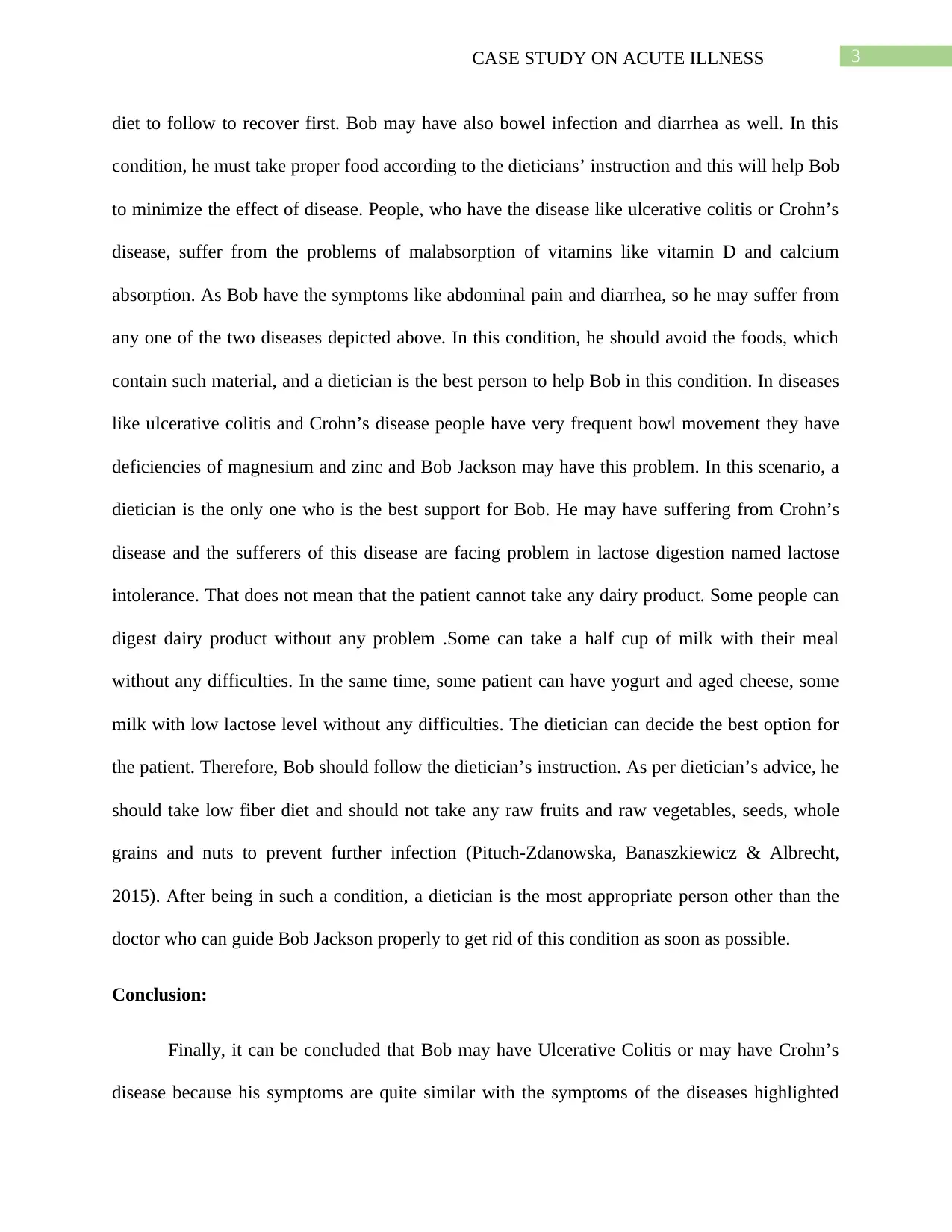
3CASE STUDY ON ACUTE ILLNESS
diet to follow to recover first. Bob may have also bowel infection and diarrhea as well. In this
condition, he must take proper food according to the dieticians’ instruction and this will help Bob
to minimize the effect of disease. People, who have the disease like ulcerative colitis or Crohn’s
disease, suffer from the problems of malabsorption of vitamins like vitamin D and calcium
absorption. As Bob have the symptoms like abdominal pain and diarrhea, so he may suffer from
any one of the two diseases depicted above. In this condition, he should avoid the foods, which
contain such material, and a dietician is the best person to help Bob in this condition. In diseases
like ulcerative colitis and Crohn’s disease people have very frequent bowl movement they have
deficiencies of magnesium and zinc and Bob Jackson may have this problem. In this scenario, a
dietician is the only one who is the best support for Bob. He may have suffering from Crohn’s
disease and the sufferers of this disease are facing problem in lactose digestion named lactose
intolerance. That does not mean that the patient cannot take any dairy product. Some people can
digest dairy product without any problem .Some can take a half cup of milk with their meal
without any difficulties. In the same time, some patient can have yogurt and aged cheese, some
milk with low lactose level without any difficulties. The dietician can decide the best option for
the patient. Therefore, Bob should follow the dietician’s instruction. As per dietician’s advice, he
should take low fiber diet and should not take any raw fruits and raw vegetables, seeds, whole
grains and nuts to prevent further infection (Pituch-Zdanowska, Banaszkiewicz & Albrecht,
2015). After being in such a condition, a dietician is the most appropriate person other than the
doctor who can guide Bob Jackson properly to get rid of this condition as soon as possible.
Conclusion:
Finally, it can be concluded that Bob may have Ulcerative Colitis or may have Crohn’s
disease because his symptoms are quite similar with the symptoms of the diseases highlighted
diet to follow to recover first. Bob may have also bowel infection and diarrhea as well. In this
condition, he must take proper food according to the dieticians’ instruction and this will help Bob
to minimize the effect of disease. People, who have the disease like ulcerative colitis or Crohn’s
disease, suffer from the problems of malabsorption of vitamins like vitamin D and calcium
absorption. As Bob have the symptoms like abdominal pain and diarrhea, so he may suffer from
any one of the two diseases depicted above. In this condition, he should avoid the foods, which
contain such material, and a dietician is the best person to help Bob in this condition. In diseases
like ulcerative colitis and Crohn’s disease people have very frequent bowl movement they have
deficiencies of magnesium and zinc and Bob Jackson may have this problem. In this scenario, a
dietician is the only one who is the best support for Bob. He may have suffering from Crohn’s
disease and the sufferers of this disease are facing problem in lactose digestion named lactose
intolerance. That does not mean that the patient cannot take any dairy product. Some people can
digest dairy product without any problem .Some can take a half cup of milk with their meal
without any difficulties. In the same time, some patient can have yogurt and aged cheese, some
milk with low lactose level without any difficulties. The dietician can decide the best option for
the patient. Therefore, Bob should follow the dietician’s instruction. As per dietician’s advice, he
should take low fiber diet and should not take any raw fruits and raw vegetables, seeds, whole
grains and nuts to prevent further infection (Pituch-Zdanowska, Banaszkiewicz & Albrecht,
2015). After being in such a condition, a dietician is the most appropriate person other than the
doctor who can guide Bob Jackson properly to get rid of this condition as soon as possible.
Conclusion:
Finally, it can be concluded that Bob may have Ulcerative Colitis or may have Crohn’s
disease because his symptoms are quite similar with the symptoms of the diseases highlighted
Secure Best Marks with AI Grader
Need help grading? Try our AI Grader for instant feedback on your assignments.
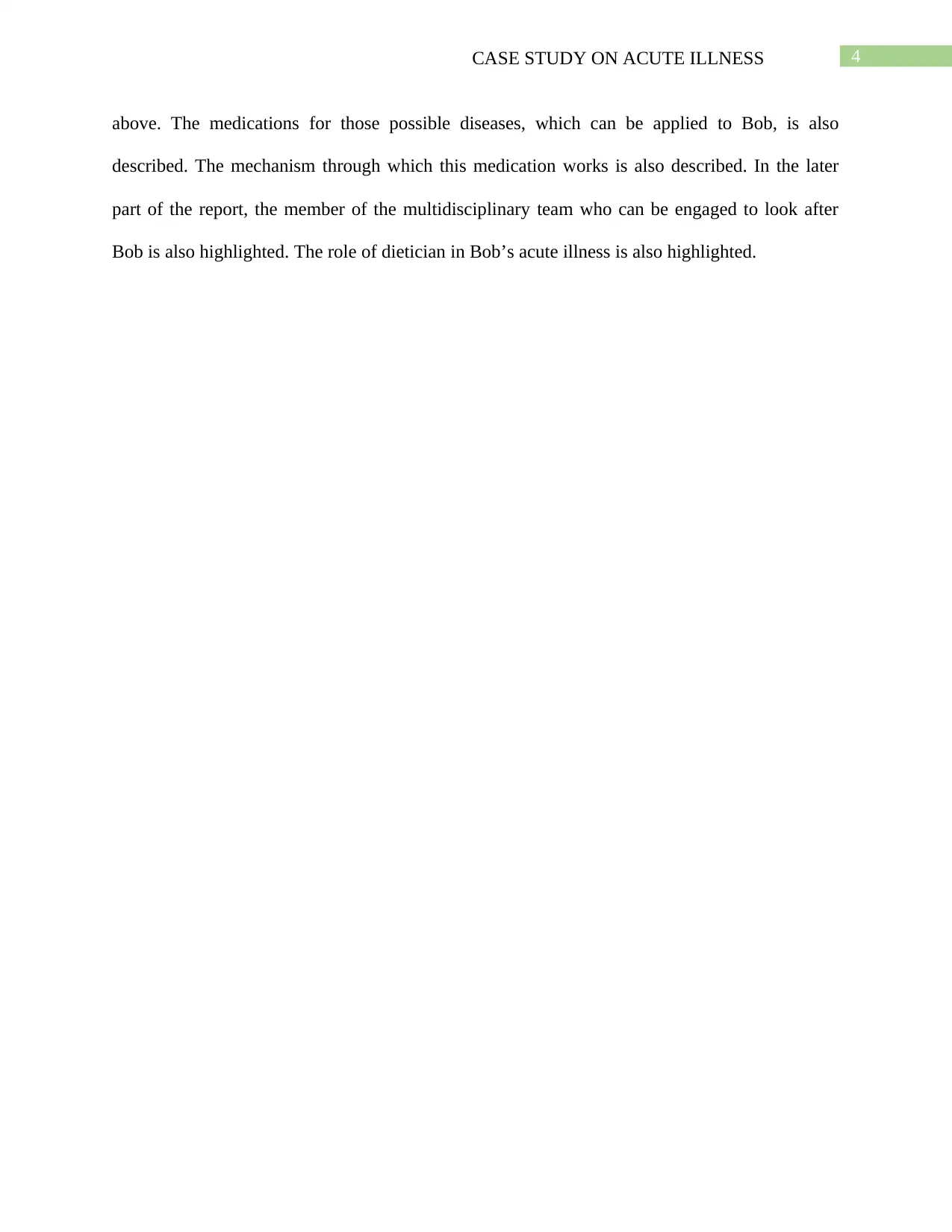
4CASE STUDY ON ACUTE ILLNESS
above. The medications for those possible diseases, which can be applied to Bob, is also
described. The mechanism through which this medication works is also described. In the later
part of the report, the member of the multidisciplinary team who can be engaged to look after
Bob is also highlighted. The role of dietician in Bob’s acute illness is also highlighted.
above. The medications for those possible diseases, which can be applied to Bob, is also
described. The mechanism through which this medication works is also described. In the later
part of the report, the member of the multidisciplinary team who can be engaged to look after
Bob is also highlighted. The role of dietician in Bob’s acute illness is also highlighted.
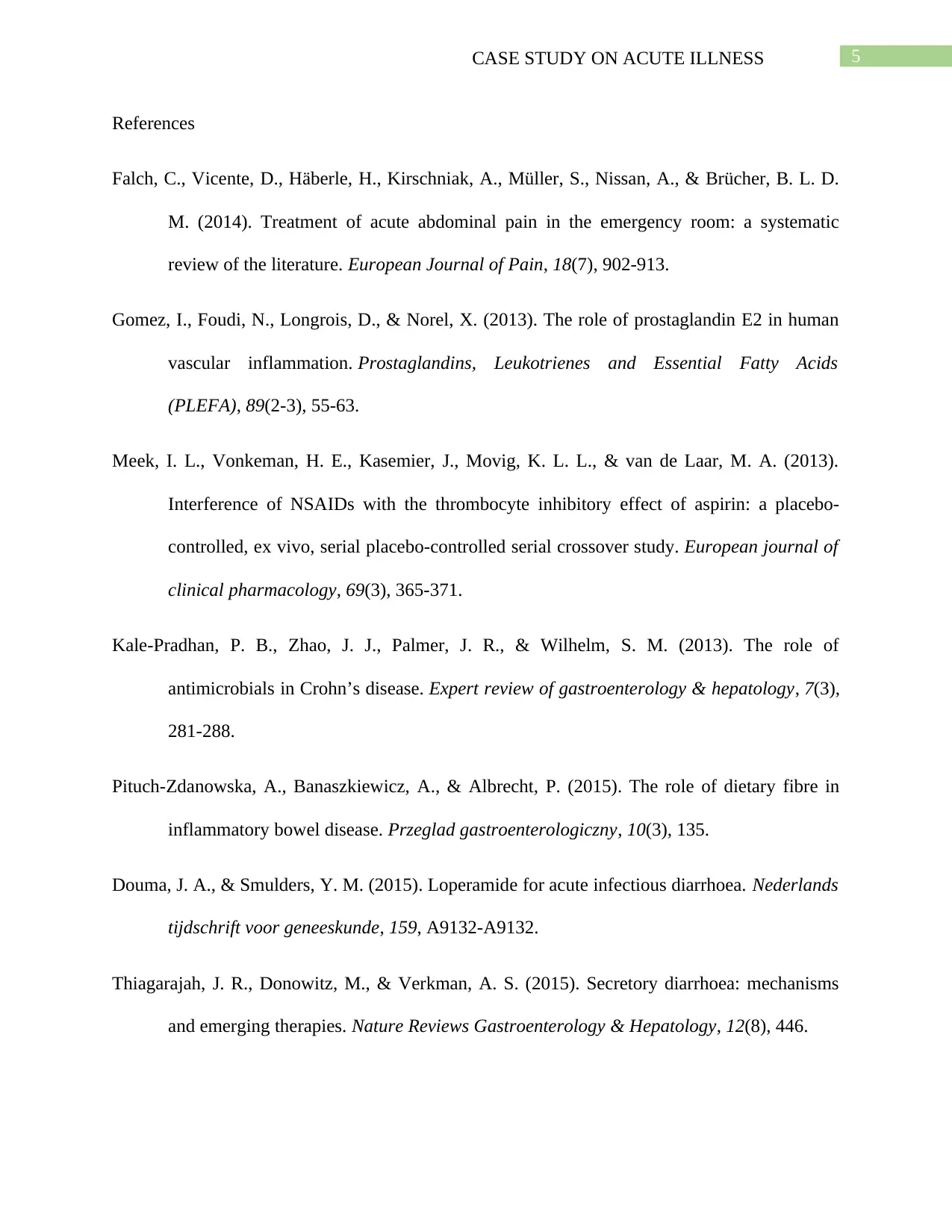
5CASE STUDY ON ACUTE ILLNESS
References
Falch, C., Vicente, D., Häberle, H., Kirschniak, A., Müller, S., Nissan, A., & Brücher, B. L. D.
M. (2014). Treatment of acute abdominal pain in the emergency room: a systematic
review of the literature. European Journal of Pain, 18(7), 902-913.
Gomez, I., Foudi, N., Longrois, D., & Norel, X. (2013). The role of prostaglandin E2 in human
vascular inflammation. Prostaglandins, Leukotrienes and Essential Fatty Acids
(PLEFA), 89(2-3), 55-63.
Meek, I. L., Vonkeman, H. E., Kasemier, J., Movig, K. L. L., & van de Laar, M. A. (2013).
Interference of NSAIDs with the thrombocyte inhibitory effect of aspirin: a placebo-
controlled, ex vivo, serial placebo-controlled serial crossover study. European journal of
clinical pharmacology, 69(3), 365-371.
Kale-Pradhan, P. B., Zhao, J. J., Palmer, J. R., & Wilhelm, S. M. (2013). The role of
antimicrobials in Crohn’s disease. Expert review of gastroenterology & hepatology, 7(3),
281-288.
Pituch-Zdanowska, A., Banaszkiewicz, A., & Albrecht, P. (2015). The role of dietary fibre in
inflammatory bowel disease. Przeglad gastroenterologiczny, 10(3), 135.
Douma, J. A., & Smulders, Y. M. (2015). Loperamide for acute infectious diarrhoea. Nederlands
tijdschrift voor geneeskunde, 159, A9132-A9132.
Thiagarajah, J. R., Donowitz, M., & Verkman, A. S. (2015). Secretory diarrhoea: mechanisms
and emerging therapies. Nature Reviews Gastroenterology & Hepatology, 12(8), 446.
References
Falch, C., Vicente, D., Häberle, H., Kirschniak, A., Müller, S., Nissan, A., & Brücher, B. L. D.
M. (2014). Treatment of acute abdominal pain in the emergency room: a systematic
review of the literature. European Journal of Pain, 18(7), 902-913.
Gomez, I., Foudi, N., Longrois, D., & Norel, X. (2013). The role of prostaglandin E2 in human
vascular inflammation. Prostaglandins, Leukotrienes and Essential Fatty Acids
(PLEFA), 89(2-3), 55-63.
Meek, I. L., Vonkeman, H. E., Kasemier, J., Movig, K. L. L., & van de Laar, M. A. (2013).
Interference of NSAIDs with the thrombocyte inhibitory effect of aspirin: a placebo-
controlled, ex vivo, serial placebo-controlled serial crossover study. European journal of
clinical pharmacology, 69(3), 365-371.
Kale-Pradhan, P. B., Zhao, J. J., Palmer, J. R., & Wilhelm, S. M. (2013). The role of
antimicrobials in Crohn’s disease. Expert review of gastroenterology & hepatology, 7(3),
281-288.
Pituch-Zdanowska, A., Banaszkiewicz, A., & Albrecht, P. (2015). The role of dietary fibre in
inflammatory bowel disease. Przeglad gastroenterologiczny, 10(3), 135.
Douma, J. A., & Smulders, Y. M. (2015). Loperamide for acute infectious diarrhoea. Nederlands
tijdschrift voor geneeskunde, 159, A9132-A9132.
Thiagarajah, J. R., Donowitz, M., & Verkman, A. S. (2015). Secretory diarrhoea: mechanisms
and emerging therapies. Nature Reviews Gastroenterology & Hepatology, 12(8), 446.
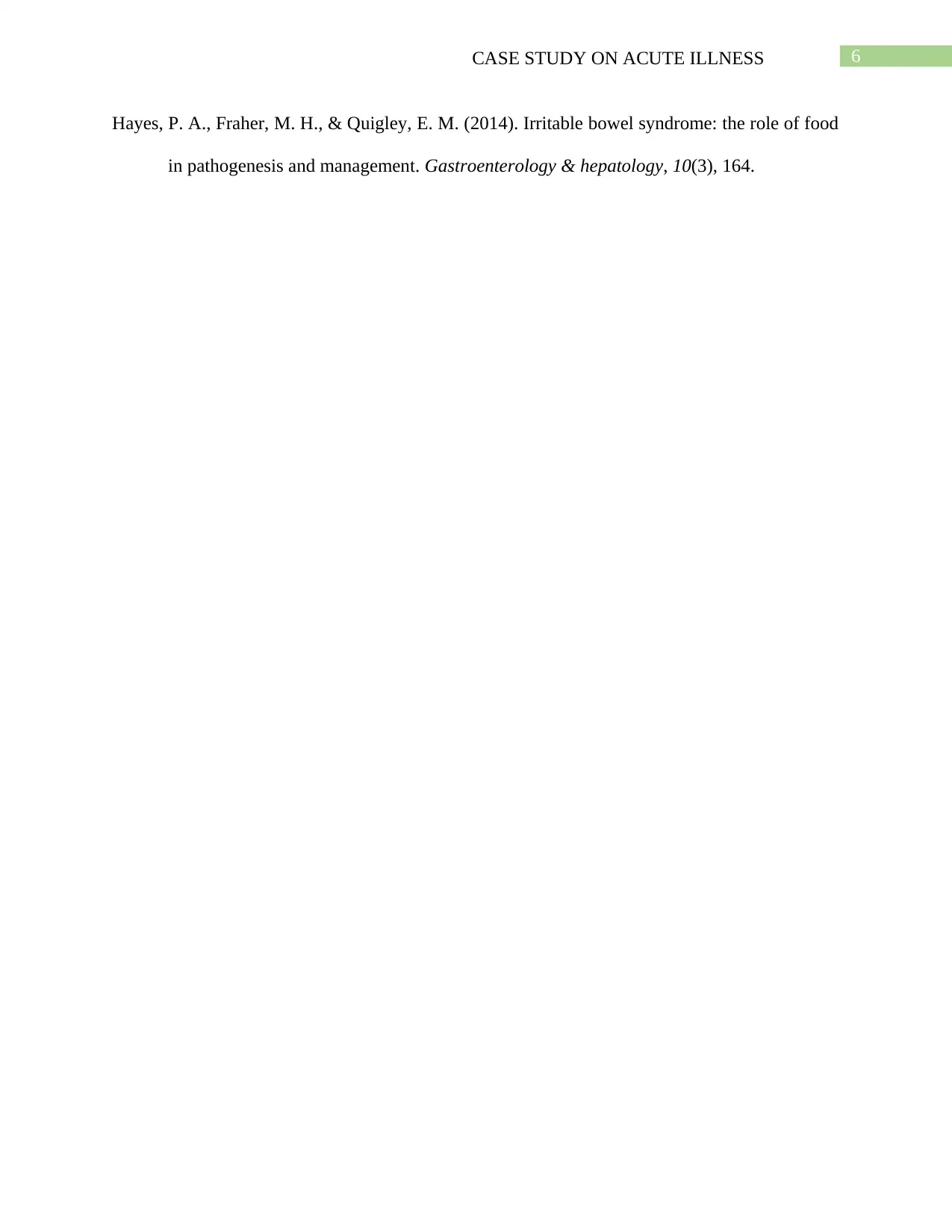
6CASE STUDY ON ACUTE ILLNESS
Hayes, P. A., Fraher, M. H., & Quigley, E. M. (2014). Irritable bowel syndrome: the role of food
in pathogenesis and management. Gastroenterology & hepatology, 10(3), 164.
Hayes, P. A., Fraher, M. H., & Quigley, E. M. (2014). Irritable bowel syndrome: the role of food
in pathogenesis and management. Gastroenterology & hepatology, 10(3), 164.
1 out of 7
Related Documents
Your All-in-One AI-Powered Toolkit for Academic Success.
+13062052269
info@desklib.com
Available 24*7 on WhatsApp / Email
![[object Object]](/_next/static/media/star-bottom.7253800d.svg)
Unlock your academic potential
© 2024 | Zucol Services PVT LTD | All rights reserved.





